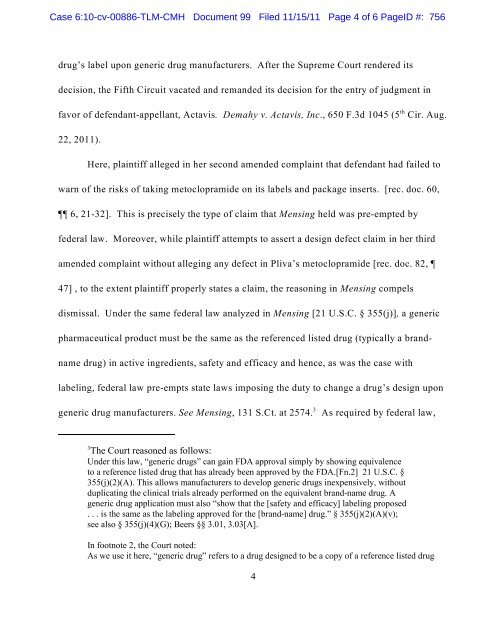UNITED STATES DISTRICT COURT WESTERN DISTRICT OF ...
UNITED STATES DISTRICT COURT WESTERN DISTRICT OF ...
UNITED STATES DISTRICT COURT WESTERN DISTRICT OF ...
Create successful ePaper yourself
Turn your PDF publications into a flip-book with our unique Google optimized e-Paper software.
Case 6:10-cv-00886-TLM-CMH Document 99 Filed 11/15/11 Page 4 of 6 PageID #: 756<br />
drug’s label upon generic drug manufacturers. After the Supreme Court rendered its<br />
decision, the Fifth Circuit vacated and remanded its decision for the entry of judgment in<br />
th<br />
favor of defendant-appellant, Actavis. Demahy v. Actavis, Inc., 650 F.3d 1045 (5 Cir. Aug.<br />
22, 2011).<br />
Here, plaintiff alleged in her second amended complaint that defendant had failed to<br />
warn of the risks of taking metoclopramide on its labels and package inserts. [rec. doc. 60,<br />
6, 21-32]. This is precisely the type of claim that Mensing held was pre-empted by<br />
federal law. Moreover, while plaintiff attempts to assert a design defect claim in her third<br />
amended complaint without alleging any defect in Pliva’s metoclopramide [rec. doc. 82, <br />
47] , to the extent plaintiff properly states a claim, the reasoning in Mensing compels<br />
dismissal. Under the same federal law analyzed in Mensing [21 U.S.C. § 355(j)], a generic<br />
pharmaceutical product must be the same as the referenced listed drug (typically a brand-<br />
name drug) in active ingredients, safety and efficacy and hence, as was the case with<br />
labeling, federal law pre-empts state laws imposing the duty to change a drug’s design upon<br />
3<br />
generic drug manufacturers. See Mensing, 131 S.Ct. at 2574. As required by federal law,<br />
3<br />
The Court reasoned as follows:<br />
Under this law, “generic drugs” can gain FDA approval simply by showing equivalence<br />
to a reference listed drug that has already been approved by the FDA.[Fn.2] 21 U.S.C. §<br />
355(j)(2)(A). This allows manufacturers to develop generic drugs inexpensively, without<br />
duplicating the clinical trials already performed on the equivalent brand-name drug. A<br />
generic drug application must also “show that the [safety and efficacy] labeling proposed<br />
. . . is the same as the labeling approved for the [brand-name] drug.” § 355(j)(2)(A)(v);<br />
see also § 355(j)(4)(G); Beers §§ 3.01, 3.03[A].<br />
In footnote 2, the Court noted:<br />
As we use it here, “generic drug” refers to a drug designed to be a copy of a reference listed drug<br />
4


